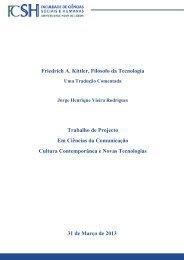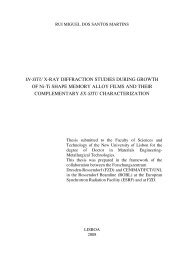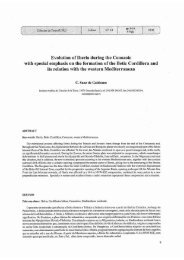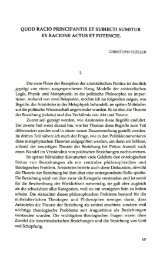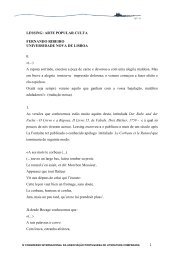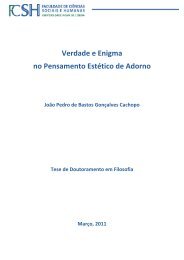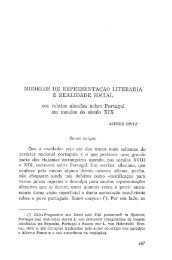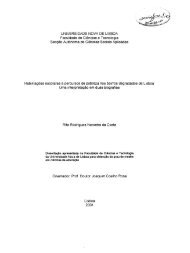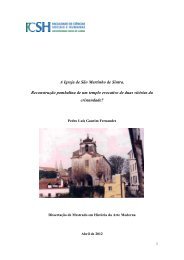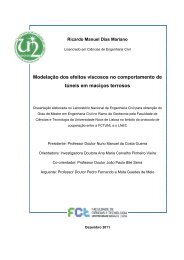Elias Manuel Morgado Pinheiro Dissertação de Mestrado em ...
Elias Manuel Morgado Pinheiro Dissertação de Mestrado em ...
Elias Manuel Morgado Pinheiro Dissertação de Mestrado em ...
You also want an ePaper? Increase the reach of your titles
YUMPU automatically turns print PDFs into web optimized ePapers that Google loves.
After c. 1600 B.C. the chariot became wi<strong>de</strong>spread in the Near East, from Egypt<br />
to Anatolia. Between c.1800 and c.1600 B.C. new innovations took place. These can be<br />
seen in the Egyptian chariots, the main source of evi<strong>de</strong>nce for this period. Perhaps the<br />
most relevant innovation is the shift in position of the axle, being attached to the chariot<br />
at the very rear of the cab, instead of right un<strong>de</strong>rneath it. This new <strong>de</strong>sign, <strong>de</strong>spite<br />
putting extra pressure on the horses‟ necks, does increase the overall stability of the<br />
vehicle. This increase of stability was paramount to the use of the chariot as a firing<br />
platform, a practice now fully wi<strong>de</strong>spread both in Egypt and in the Levant. The box is<br />
ma<strong>de</strong> of bent wood and rawhi<strong>de</strong>, being an average of 1.0m wi<strong>de</strong> and 0.5m <strong>de</strong>ep 22 . Since<br />
the focus was on speed rather than protection, the crew was shiel<strong>de</strong>d only by a stretched<br />
ox hi<strong>de</strong>, in the front of the cab, while the si<strong>de</strong>s r<strong>em</strong>ained vulnerable. The six spoked<br />
wheels averaged 90cm in diameter and were ma<strong>de</strong> with light but sturdy materials,<br />
mainly elm, ash, and almond. The wheels were of an extr<strong>em</strong>ely complex <strong>de</strong>sign: each<br />
spoke was ma<strong>de</strong> by gluing together two halves of bent-wood V-shaped pieces. This<br />
structure would then be attached to the nave of the wheel through the use of fresh cattle<br />
intestines that would later har<strong>de</strong>n and shrink as it dried, keeping the entire structure<br />
together. The rim was ma<strong>de</strong> by binding four felloes to four felly-bands, united by strips<br />
of rawhi<strong>de</strong> and reinforced with bronze wire, while an outer tyre, also ma<strong>de</strong> of rawhi<strong>de</strong>,<br />
would compress the entire structure. The wheels were secured to the axle by a lynch-<br />
pin. The axle was much larger than the superstructure, averaging 1.45m in length. This<br />
allowed for sharp turns, and contributed to the stability of the vehicle, by providing<br />
significant shock absorption. 23<br />
Each chariot was manned by a crew of two: the charioteer, often carrying a<br />
shield, and a “chariot warrior”, armed with bow and arrows, as well as maces, axes and<br />
khopesh, presumably for dismounted combat. However, the main weapon was the<br />
composite bow, and the chariots were fitted with quivers of arrows for extra<br />
ammunition.<br />
For protection, these warriors wore either textile armour (linen layers mixed<br />
with resin) or scale armour (ma<strong>de</strong> of bronze or har<strong>de</strong>ned leather). In addition to these<br />
two crew m<strong>em</strong>bers, the chariots were <strong>de</strong>ployed in conjunction with light-armoured<br />
22 Littauer and Crouwel, 1980, §4<br />
23 Fields, 2006, p.16<br />
16





